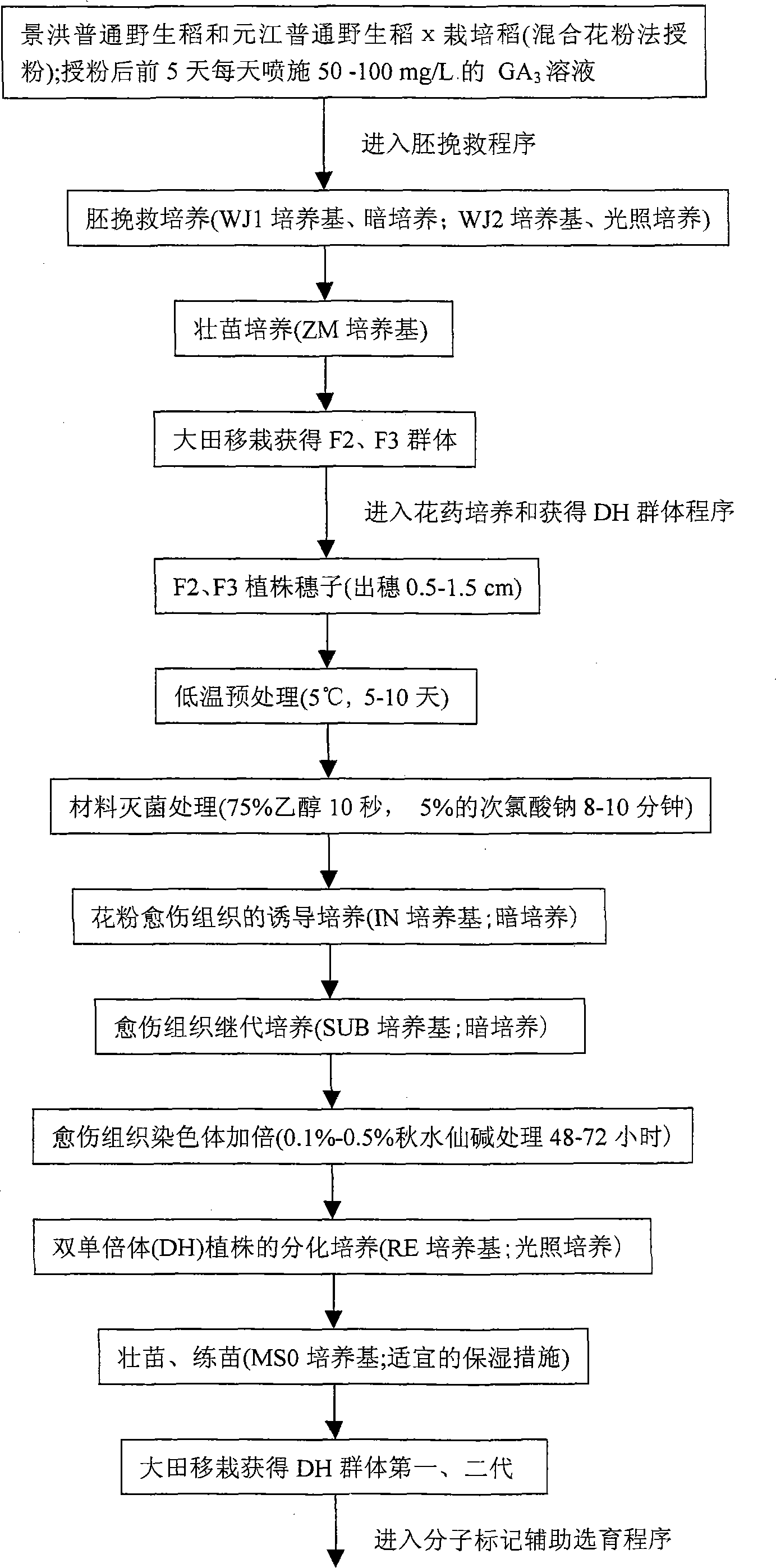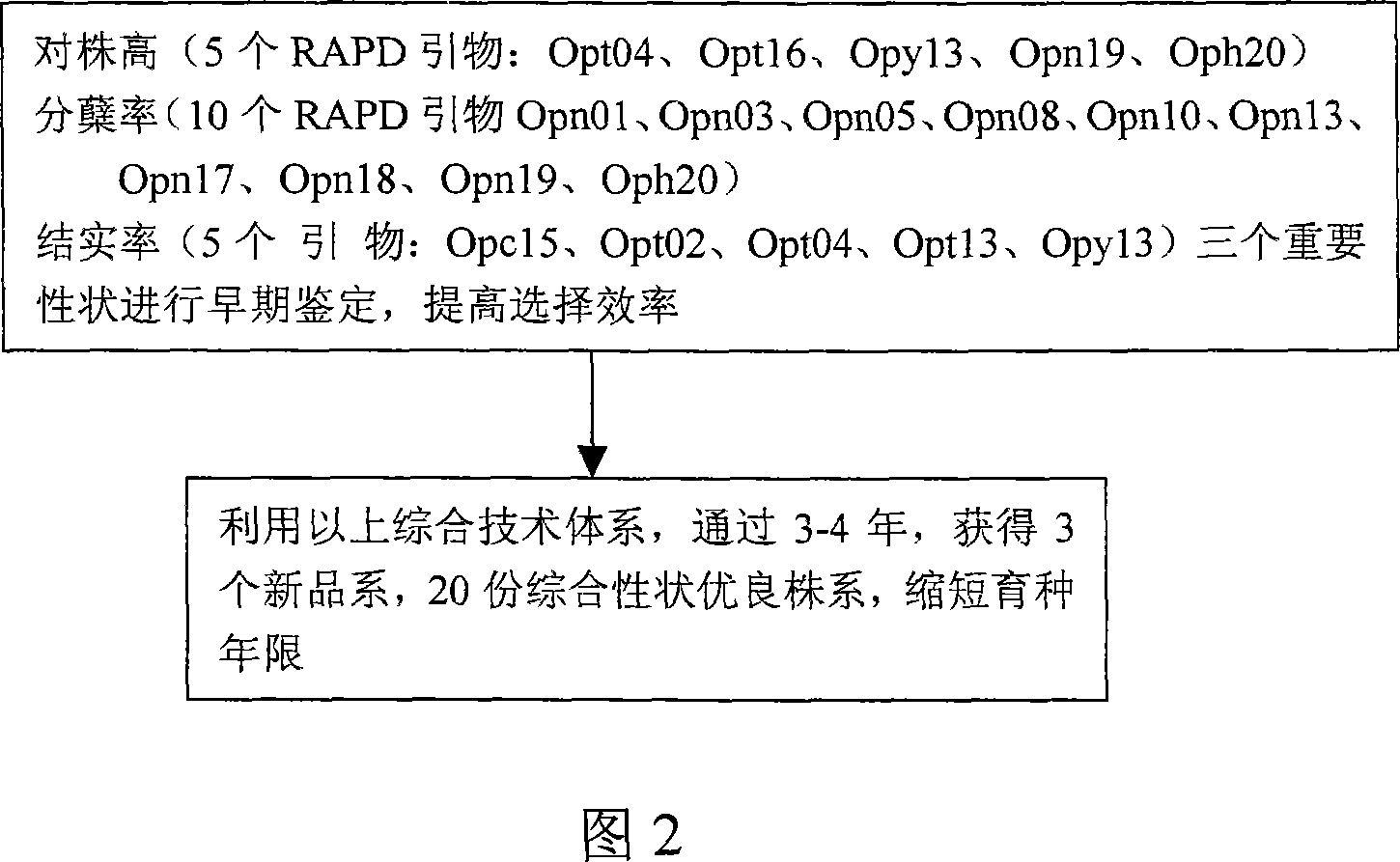Wild-rice distant hybridization high-efficient cultivating superior progeny method
A technology of distant hybridization and wild rice, applied in the field of plant cultivation, can solve the problems of difficulty in character stability, difficulty in hybridization between cultivated rice and wild rice, and difficulty in receiving hybrid seeds, so as to speed up the homozygous stability of traits and shorten the breeding period. , accelerate the effect of homozygous
- Summary
- Abstract
- Description
- Claims
- Application Information
AI Technical Summary
Problems solved by technology
Method used
Image
Examples
Embodiment 1
[0067] 1. Hybridization, embryo rescue and strong seedling cultivation of cultivated rice
[0068] 1) The cultivated rice is sown in batches to adjust the flowering period of the cultivated rice to meet that of the wild rice. In the wild hybridization, cultivated rice was used as the female parent, and Yuanjiang common wild rice was used as the male parent for hybridization. Before the cultivated rice blooms, usually in the morning, cut off 1 / 3 of the chaff with scissors, and then use tweezers to pick out the anthers and then bag them to prevent powder clustering. Before the female parent is pollinated, a certain amount of female parent pollen is collected to make it die naturally (the rice pollen will die in a short time after it is emitted from the anther). The dead cultivated rice pollen is mixed with wild rice pollen to pollinate and bag the female parent. In this method, the recognition protein on the pollen of cultivated rice can still induce the stigma to accept the p...
Embodiment 2
[0115] The method is basically the same as the above-mentioned embodiment 1, the difference is:
[0116] 1. The parental material of wild rice is another important type of wild rice in Yunnan, namely Jinghong wild rice.
[0117] One, 1) in: from the 2nd day of pollination, spray the GA3 (gibberellin) solution of 100mg / L to the pollination ear continuously for 3-5 days, spray 3 times every day.
[0118] 1. 2) During rice embryo rescue: the composition of medium WJ2 is: MS+NAA0.5mg / L+KT1mg / L+30g / L sucrose+9g / L agar, pH5.8.
[0119] 2. The pollen cultivation of wild hybrid offspring:
[0120] 4) Middle: The pollen callus induction medium IN formula was adjusted to: N6+2,4-D 3.0 mg / L+KT 1.0 mg / L+sucrose 30 g / L+agar 9 g / L, pH 5.8.
[0121] 5) Medium: The composition of the subculture medium SUB is: N6+2,4-D2.5mg / L+KT1mg / L+sucrose 30g / L+agar 9g / L, pH5.8;
[0122] 6) Medium: The callus after subculture for 2 weeks was treated with 0.5% colchicine (sterilized by filtration) under s...
Embodiment 3
[0127] The method is basically the same as the above-mentioned embodiment 1, the difference is:
[0128] 1. 2) During rice embryo rescue: the composition of medium WJ2 is: MS+NAA0.25mg / L+KT2mg / L+30g / L sucrose+9g / L agar, pH5.8.
[0129] 2. The pollen cultivation of wild hybrid offspring:
[0130] 4) Middle: The pollen callus induction medium IN formula was adjusted to: N6+2,4-D2.5mg / L+KT0.5mg / L+sucrose 30g / L+agar 9g / L, pH5.8.
[0131] 5) Medium: The composition of the subculture medium SUB is: N6+2,4-D2.0mg / L+KT0.6mg / L+sucrose 30g / L+agar 9g / L, pH5.8;
[0132] 6) Medium: The callus after subculture for 2 weeks was treated with 0.3% colchicine (sterilized by filtration) under sterile conditions, and then put back into the incubator at 26°C for 72 hours, and the excess was sucked off after completion. colchicine, inoculated on differentiation medium to regenerate plants.
[0133] 7) Middle: The formula of DH plant differentiation medium RE is adjusted to: N6+KT2.0mg / L+BA0.5mg / L...
PUM
 Login to View More
Login to View More Abstract
Description
Claims
Application Information
 Login to View More
Login to View More - R&D
- Intellectual Property
- Life Sciences
- Materials
- Tech Scout
- Unparalleled Data Quality
- Higher Quality Content
- 60% Fewer Hallucinations
Browse by: Latest US Patents, China's latest patents, Technical Efficacy Thesaurus, Application Domain, Technology Topic, Popular Technical Reports.
© 2025 PatSnap. All rights reserved.Legal|Privacy policy|Modern Slavery Act Transparency Statement|Sitemap|About US| Contact US: help@patsnap.com



